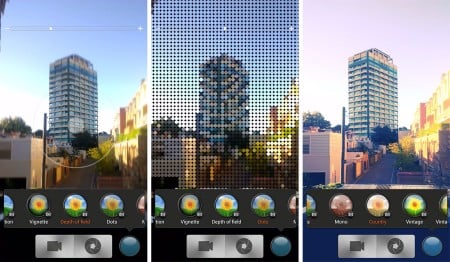Performance
When you first play with the HTC One X, it’s hard not to admire it. While it doesn’t have the same solid aluminium chassis that we loved about the HTC Legend, the One X is still one sexy device.
The polycarbonate body has been put together beautifully, and the form hugs the palm of your hand, providing a feeling that really is comfortable. It’s almost like the HTC One X was made for your hands, it feels that good.
At 8.9mm, it’s certainly thinner than a lot of the handsets we see, and manages to be thinner than Apple’s iPhone 4S.
In a first for HTC, there is no removable back, as the One X is, like many laptops these days, an all in one unit. With this design, you can rest assured that if you drop your One X, the rear cover won’t break and the battery won’t fall out.
The one-piece handset is easy to carry and feels excellent, and we love it.
The screens adds to this, providing one of the nicest large screens we’ve seen yet. HTC first dabbled with this size in last year’s Sensation XL, but since then, the resolution has improved dramatically. With its 720p screen, the One X is very clear and offers strong colour representation from every angle.
HTC has done more than just made a beautiful phone, as the company has also tweaked Android so that it’s easy to use.
In its fourth official iteration, HTC’s Sense overlay is better than ever. Last year’s lock-screen with draggable shortcuts is still present, but now everything feels smoother. Animations connect everything you do, the menu tabs can be changed, and the shortcut to the Google Market (now renamed Play Store) are present in the program menu.
Up to seven widgetised home-screens are available for you to swipe between and HTC allows you to change the four dock icons to your most used shortcuts, while also offering better widget selection and the easy snap-grid system for placing icons.
Using the phone is a little different to past HTC devices, as the four buttons we’re used to seeing on handsets has been reduced to three. The application switch button probably won’t be used as often, and we’d have preferred the old menu button as this is now software based and tends to appear in different locations depending on the program you’re running.
For the most part, the Tegra 3 processor is a beast, chugging along very well and only rarely hiccuping. When it does, it was something we noticed, as games would stall for a couple of seconds. We suspect most people will have no problems with the speed on offer from the handset, however, and expect there to be the occasional issue given this is the first time the Tegra has appeared in a mobile handset.
There’s also plenty of storage on offer, provided you’re happy with a maximum of 25GB. Sure, the phone itself has 32GB of on-board storage, but you’re only left with “25.24GB”, a size that should be enough for many, but may cause problems for those installing heaps of apps, loading lots of tunes, and taking a plethora of pics and vids. To aid in this, Dropbox and HTC have partnered to offer 25GB of free cloud storage to upload things to, a huge jump on the 2GB you can normally receive for free from the online storage provider.

Over on the camera side of things, HTC has done a superb job, with the speed and quality something that will be easily noticed.
HTC’s new handsets take advantage of a dedicated camera chip offering fast capture and processing for the smartphone camera. Effectively, you can fire 4 shots per second on the One X, with up to 99 fired in continuous burst mode. Once you’ve fired a full burst (stopping when you want to), you can choose the best photo and either save or ditch the rest.
We found the camera worked better in macro mode on the One X than it did on any other Android handset, and features we had seen on other handsets – such as panorama mode and HDR – were present too. Video can be captured in Full HD 1080p from the rear camera, but slow-motion video is also offered in a lower resolution format.

Even playing back the videos supports image capture, as you’re able to grab stills of videos by clicking a camera button while you’re watching video you’ve just recorded. As a feature, we’re not sure we’d use this often, but have to admire the concept that HTC has allowed for: you could record video of someone and then grab stills of that video, perfect for recording the little ones playing in the backyard and giving you the best of both worlds.
One thing you may find when using the camera is that the lens can get a little warm. It’s certainly not scalding hot, but it’s worth pointing out.







No expandable memory &no regular SIM card are two very big disadvantages Hope these will be take care in the next series. Otherwise a good phone Gd
You’re unlikely to see anymore regular SIM cards in HTC handsets now that microSIM is the standard.
MicroSD on the other hand, that should make an appearance. We hope.
is there a way to have the htc one x one telstra? coz telstra isnt doing contacts for the phone but can you just throw telstra sim in it and itl work normally ?
Yup. I review all phones with my own Telstra SIM in them unless otherwise noted.
It won’t give you a 4G connection – you’ll need the One XL for that – but a Telstra SIM will work in an unlocked One X.
I can’t send music files via bluetooth on my One XL, how can I do this?